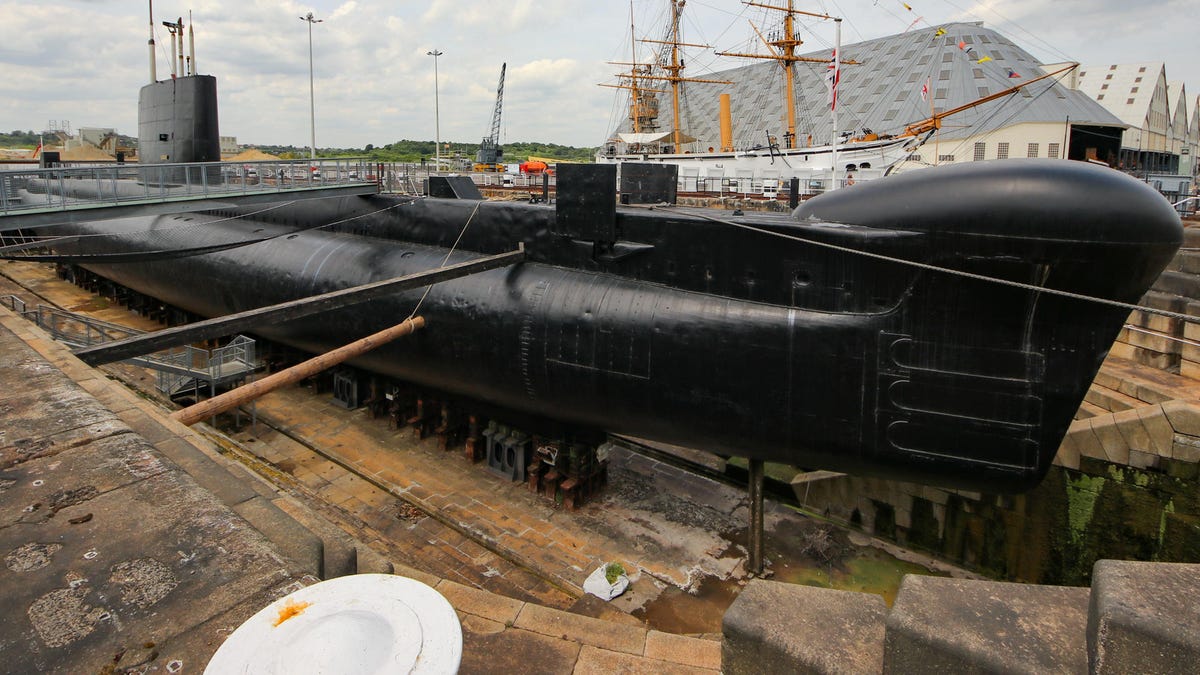 Why You Can Trust CNET
Why You Can Trust CNET Silence in the deep: Inside the HMS Ocelot stealth submarine
The Ocelot is a British sub named after a rare species of wild feline. The cat photos from this tour are light on cute, heavy on cool military tech.

For 29 years, Her Majesty's Submarine Ocelot quietly patrolled the Atlantic. Many of her missions are still classified to this day, nearly 30 years removed from her decommission in 1991. For months at a time, her crew of 69 men would stealthily listen and track enemy subs and ships using advanced sonar arrays.
She covered over 90,000 miles in her years of service and her duties, at least the declassified ones we know about, ranged from routine patrols, advanced equipment testing and even a rescue operation. She was the last boat built for the Royal Navy at Chatham Dockyard, where she now sits.
As a museum ship, she is in fantastic condition and easily accessible, sitting high in a former drydock. A rarity for a sub, you can actually walk under her hull, and get up close and even touch the 1,600 tons of metal and plastics. Here's how she looks, inside and out.
Silence is the key
The Ocelot, named after the cat of the same name, is the 8th ship in the Oberon-class, and the oldest remaining. Designed in the '50s to replace the post-war Porpoise-class, they were an improvement in a number of ways, not least stealth. Anything that could make noise was isolated from the hull. She was one of the quietest ships of her day, and was tasked with a number of Cold War missions that we'll probably learn about eventually. But maybe not. The steel used for the hull was also an upgrade, allowing the sub to dive even deeper into the abyss.
The bulbous nose held an advanced sonar array, the ears, and technically "eyes" of the sub. Initially, she had six forward torpedo tubes, and two aft. As you'll see in the photo tour, the rear two were removed as the Ocelot's mission evolved.
While the Ocelot's sister ship, the Onyx, fought in the Falklands War, the Ocelot never saw open conflict. In addition to patrol and training missions, she also helped test a new torpedo for the Royal Navy. She was decommissioned in 1991. The BBC interviewed some of the crew about what life was like on board.
Far side of the world
While the Oberon-class was built for the Royal Navy, several were sold to allies and nations of the Commonwealth. The Ocelot is the only one left in Britain, but others are available to tour around the world.
The most remote is the HMAS Ovens, in Freemantle, just south of Perth on the west coast of Australia. I toured the Ovens in 2015, which you can read about in Hot sub time machine: A photo tour of the HMAS Ovens submarine and see in the gallery below.
Guns and ships and so the balance shifts
The Ocelot is located at the Chatham Historical Dockyard, about an hour east of London. It's worth taking a bus to the docks from the train station, if you're going on foot. The walk is longer than it looks on Google, as the pedestrian entrance is on the far side of the facility, not where Google Maps says it is. There are two other ships and more to see, and we'll be covering them in a few weeks.
Guided tours of the Ocelot are available throughout the day, and after you buy your ticket for the Dockyard, you can pick a time that's convenient for you. Tickets are £24 (approx. $32USD/$43AUD), and are a bit cheaper if you buy them online. The Docks are open mid-February to early December, 10am to between 4 and 6 depending on the season.
In the meantime, check out the gallery above for a look inside this classic diesel-electric submarine.
As well as covering audio and display tech, Geoff does photo tours of cool museums and locations around the world, including nuclear submarines, aircraft carriers, medieval castles, epic 10,000-mile road trips and more.
Also check out Budget Travel for Dummies, his travel book, and his bestselling sci-fi novel about city-size submarines. You can follow him on Instagram and YouTube.

